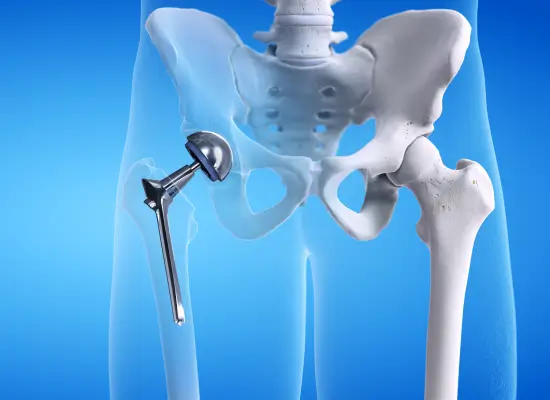Ans. Patients are usually able to walk after 3-6 weeks after getting the surgery for hip replacement in Bangalore. This is mostly possible with proper medication and care, such as physical therapy and aided walking.

Synopsis
Hip conditions can deteriorate a person’s daily activities and movements, such as - walking, climbing stairs, etc. Conditions such as arthritis, joint degeneration, fractures, etc., can lead to chronic pain, stiffness, and reduced mobility. This increases dependency on others and degrades the quality of life. Hence, Total Hip Replacement in Bangalore improves the quality of life by reducing pain, increasing range of motion, and enhancing mobility. Gleneagles Hospitals can help patients relieve their pain effectively with personalised Total Hip Replacement in Bangalore, which aims at restoring mobility, reducing pain, etc.
What Is Total Hip Replacement?
Total Hip Replacement surgery, also known as total hip arthroplasty, is done to address hip pain that may have occurred due to damage or a diseased hip joint. The surgery involves replacing the hip joint with artificial implants. It is usually done to relieve pain and restore mobility in patients who have severe arthritis, fractures, or other degenerative hip conditions.
During the surgery, the damaged femoral head (ball of the hip joint) is removed & replaced with a metal or ceramic prosthetic. The acetabulum (hip socket) is also resurfaced with a durable cup - often made with ceramic, plastic, or metal. They allow smooth joint movement.
Types Of Total Hip Replacement
Cemented Total Hip Replacement Surgery In cemented total hip replacement surgery, the prosthetic components are secured to the bone using bone cement, also known as - polymethyl methacrylate. This ensures immediate fixation, which makes it the best choice for individuals with weaker bones. The cement hardens quickly, which allows for better and faster recovery.
Uncemented Total Hip Replacement Surgery Uncemented total hip replacement surgery depends on the natural ability of the bone to grow into the implant. This creates a biological fixation. The prosthetic components have a porous or coated surface, which allows bone cells to adhere and integrate over time. This is mostly recommended for younger and active patients.
Minimally Invasive Total Hip Replacement Surgery This technique uses a smaller incision that reduces muscle and tissue damage. Patients may experience less pain, quick recovery, and shorter hospital stays. However, it may not be suitable for all patients.
When Is It Done?
Here are some that indicate the person needs total hip replacement -
Difficulty Walking And Standing Severe hip pain can make daily activities challenging, including - standing, walking, climbing stairs, and even putting on shoes. If a patient experiences difficulty getting in and out of the chair, it may indicate hip dysfunction. If these issues are left to be, they may worsen with time and reduce mobility. Thus impacting overall life. If these issues persist despite proper medication or physical therapy, a total hip replacement may be necessary.
Constant Hip Pain Persistent hip pain that does not respond to medication and other treatments might be an indication that the patient may need a total hip replacement. This pain may occur during simple movements, such as - severe osteoarthritis, rheumatoid arthritis, or joint deterioration due to injury. THR can help people restore their mobility and improve their overall quality of life.
Unexpected Swelling And Inflammation Sudden swelling and inflammation, in addition to tenderness in the joint, can signal inflammation, joint infection (septic arthritis), or worsening arthritis. This swelling may cause stiffness, warmth, and difficulty moving the hip. In certain cases, the inflammation causes fluid buildup in the joint. This increases discomfort and restricts movement.
Limping With One Leg Limping due to hip pain, stiffness, or muscle weakness may indicate advanced joint damage or cartilage loss. As the hip deteriorates, the body compensates by altering gait. This can strain the lower back, knee, and other joints. Over time, an uneven walk may also lead to joint misalignment, muscle imbalances, and increased pain in other areas. If limping becomes consistent and affects the balance, total hip replacement may be necessary
Your health matters – get expert advice today.
Preparation For Total Hip Replacement
Before the surgery, doctors will give the patient a list of required diagnostics, such as X-rays, MRI, CT scans, blood tests, and synovial fluid analyses, among many others. During the consultation, the doctors will ask the patients about the symptoms of hip pain, and depending on the test results, they will determine which hip replacement patients require.
They may also ask about the current medications and if they have diabetes. This is because surgery involves incision, and until the blood sugar level is normal, it is challenging to proceed with the surgery. In addition, the doctors also discuss the risks and complications. Here are some recommendations the doctor-in-charge may offer -
- Seven days before the surgery, the patients are advised to stop taking NSAIDs (Nonsteroidal Anti-Inflammatory Drugs). This is because they interfere with blood clotting, which can lead to an increase in blood loss during the surgery.
- If the patient is on blood thinner, they may be advised to stop a few days before the surgery.
- Also, they will be advised to stop taking any supplements such as - ginseng, Vitamin E, fish oil, etc.
The day before the surgery, the patients are advised to bathe with antibacterial soap. Also, they will be asked not to eat or drink anything a day before the surgery.

How Is Total Hip Replacement In Bangalore Done?
Patients are asked to reach the hospital early to get a few tests done and have their blood pressure monitored. Once done, they are given anaesthesia to help them relax. The surgery often takes around 1-2 hours - depending on how damaged the hip is, the cause of the damage, and the general health of the patient. Here are the steps required to follow for total hip replacement -
- The surgeon makes a cut, or several cuts, in the back of the side of the hip to take the damaged hip apart.
- The top end of the thigh bone (ball joint) is cut off and removed.
- A new metal or ceramic ball is fitted to the end of the thigh bone.
- Then, the hip socket is drilled out, and a new socket (either plastic or ceramic) is added.
- Once done, the new hip is fitted back together. The surgeon stitches the incision with surgery glue or clips and covers it with proper dressing & bandage.
- After the surgery, the patient is taken to the surgery room, where they are monitored and taken care of.
Aftercare And Recovery
It may take several months to recover from a hip replacement, which also depends on the age and general health of the patient. After the surgery, it is important to follow the doctor’s advice thoroughly. This helps in a smooth recovery. The patient is given painkillers to help with the sore hip. Also, drain tubes are put in the hip to prevent fluid accumulation in the surgical site.
The patient will be allowed to go home 2-3 days after the surgery, depending on the health of the condition. Before going home, a physiotherapist will talk to them about their daily activities and recommend certain light exercises. There might be some pain and swelling in the surgical site for a few days, but with proper care, they will be gone.
Risks & Complications
Though total hip replacement in Bangalore is considered a safe option, it may also carry some risks and complications. Here are certain risks and complications that might follow after the surgery -
- Deep Vein Thrombosis is common after a hip replacement. For this, doctors can give the patients anticoagulants. Sometimes, a blood clot in the hip may travel to the lungs (pulmonary embolism), which can cause serious complications.
- There might be a risk of wound infection. If the infection goes deep into the hip joint, there might be a need for further surgery. Hence, doctors often treat wound infections using antibiotics.
- During the surgery, there is a risk of damage to the surrounding ligament, nerves, or tissue. This usually may heal on its own or can be repaired during the surgery.
- Sometimes, the surgery can lead to a difference in leg length. This means one leg is bigger than the other.
- Though rare, the patient may also experience hip dislocation. If the patient hears a clicking or popping sound, they are advised to go to the doctor immediately.
In addition to this, immediate complications that a patient may experience are -
- Fever
- Chills and shiver
- Oozing or pus from your wound
- Throbbing or cramping in the hip and leg
- Redness, tenderness, swelling, pain that might be getting worse
Why Choose Gleneagle Hospital For Total Hip Replacement Surgery In Bangalore?
Here are some reasons why you must choose Gleneagle Hospital for hip replacement surgery -
- We offer pre-operative assessment programs to ensure that the patient is fit for surgery.
- We also offer post-surgical care, such as - physical therapy, pain management, etc., that help patients recover properly.
- We have advanced diagnostic imaging (MRI, CT scans), in addition to modern operation theatres and robotic systems that help in surgery.
- Our surgeons are trained internationally and hold certifications that showcase their track record.
As the best hospital for hip replacement surgery in Bangalore, we ensure a low complication rate and a higher success rate - this has added to our reputation.
Our Doctors
View allDr Brahmaraju T J
Sr Consultant - Orthopaedics & Joint Replacement Surgery
MBBS, D Ortho, DNB (Ortho), MS (Ortho), Fellowship in Joint Replacement, Fellowship Arthroscopy (Germany)
Dr Basavaraj C M
HOD & Sr Consultant - Orthopaedic Specialist & Joint Replacement Surgery
MBBS, D Ortho, DNB (Ortho), MRCS (Glasgow), FRCS (Trauma and Ortho), Fellowship in Arthroplasty (UK)
Frequently Asked Questions
Ans. The 90% rule advises patients to avoid bending their hip joints beyond a 90-degree angle during the early stages of recovery. This helps minimise the risk of dislocation and ensures that the new joint heals properly.
Ans. The method of total hip replacement is the posterior approach, where the patient lies on the unaffected part of the hip, and the surgeon conducts the surgery by splitting the muscle and tendons near the buttock.
Ans.Here are three rules that the doctors at Gleneagles will advise you after the total hip replacement in Bangalore-
- Don’t bring the knee up higher than the hip.
- Don’t try to pick things up from the floor.
- Don’t lean forward while sitting.
Ans. A hip replacement is mostly necessary if both the hip joints are damaged to such an extent that the pain is not responding to other treatments, the range of motion is restricted, etc.


















